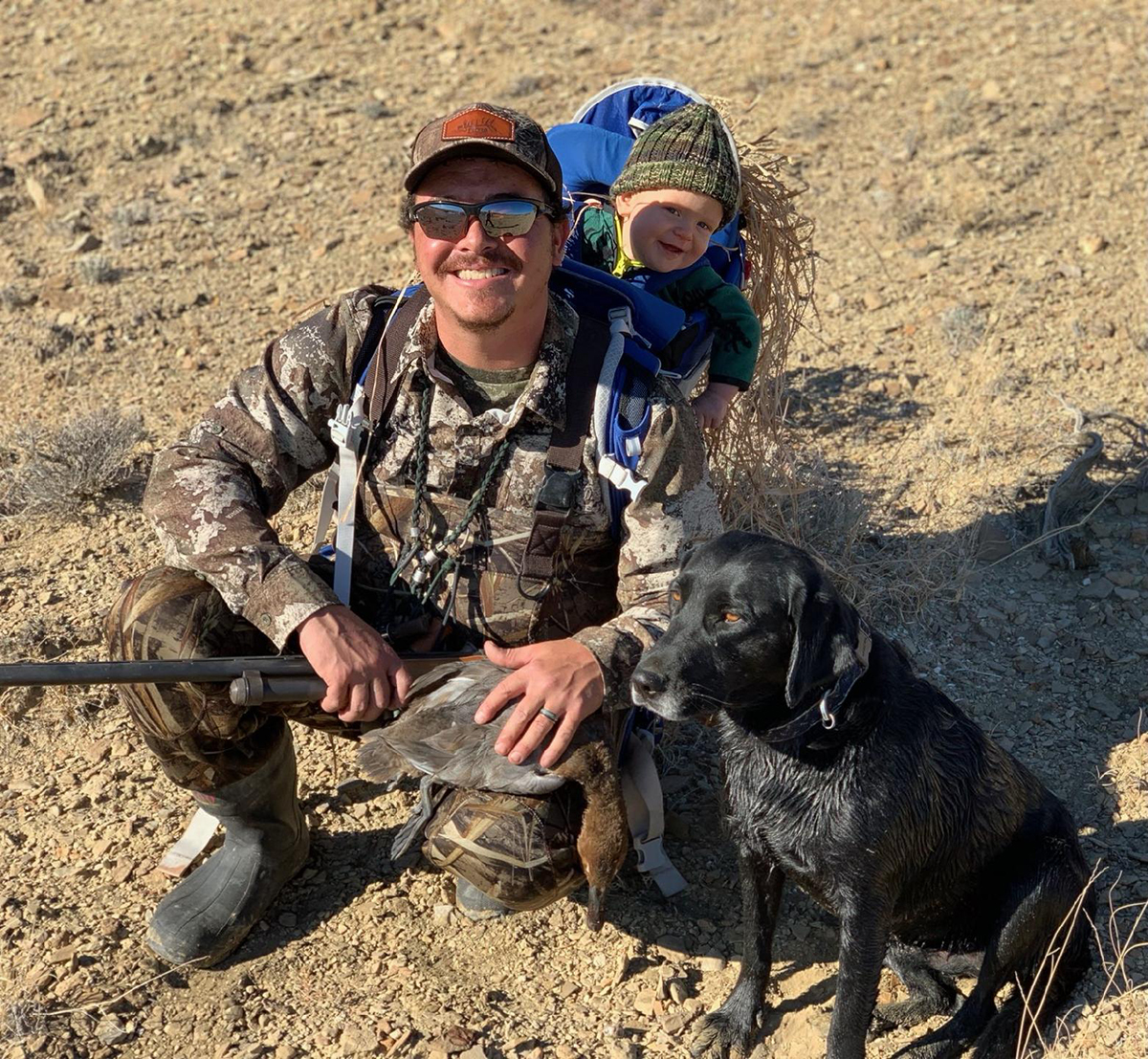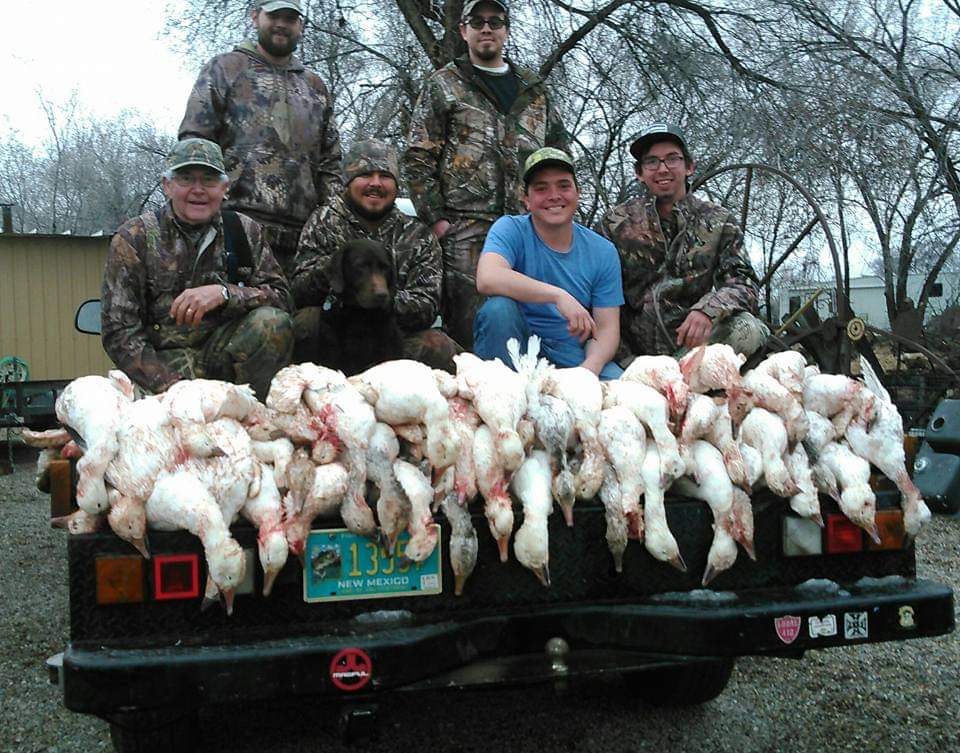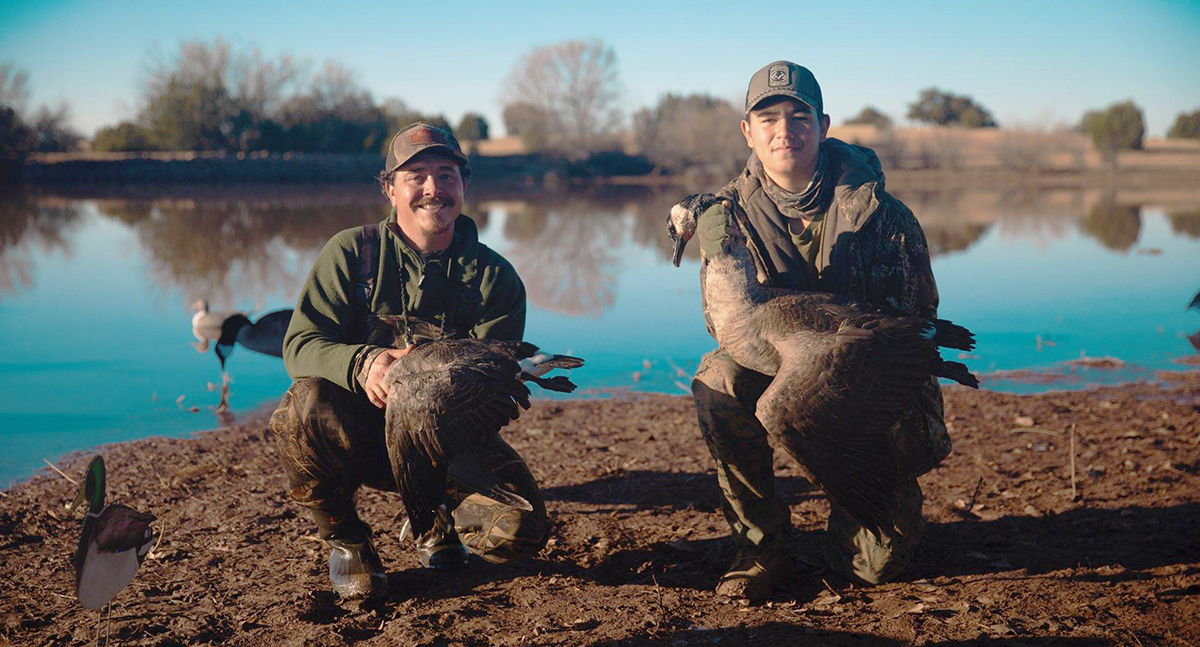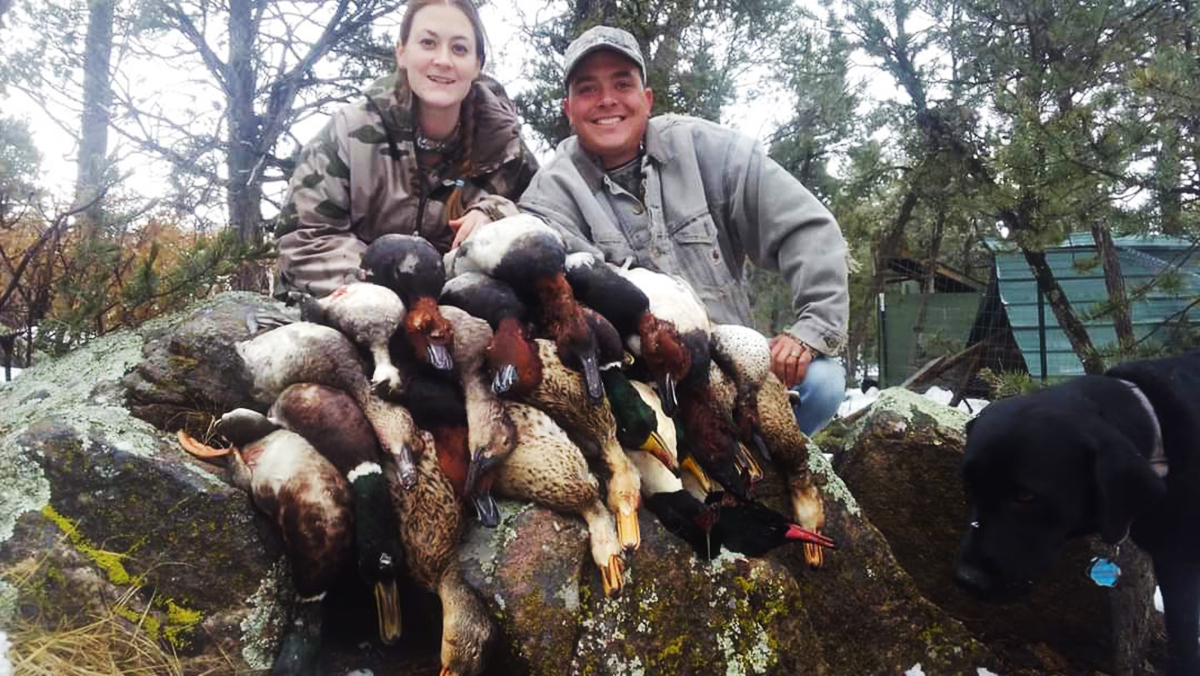In the Arena: Matthew Monjaras
TRCP’s “In the Arena” series highlights the individual voices of hunters and anglers who, as Theodore Roosevelt so famously said, strive valiantly in the worthy cause of conservation.
Matthew Monjaras
Hometown: Albuquerque, New Mexico
Occupation: Founder and CEO of Impact Outdoors
Conservation credentials: Fundraising for local conservation projects, revamping wetlands and streambanks, creating opportunities for returning veterans to heal in the outdoors, and hosting outdoor education events for local families
Matt Monjaras is like many lifelong outdoorsmen—he found his passion for hunting and fishing at a young age, felt shaped by his experiences on public lands, and developed an appreciation for the solace he found while tuned into the pursuit of fish or game. But what makes Matt unlike many of us is his effort to give this gift to others in his community by spearheading volunteer conservation efforts, fundraising, and mentorship.
Here is his story.
I was born in Colorado but raised in New Mexico along the banks of the Rio Grande. From Las Cruces to Southern Colorado, I spent many lifechanging hours pursuing bullfrogs and catfish along the river. I was also lucky enough to spend summers with my uncle, where I’d be waist-deep in the San Juan River stocking trout and learning about aquatic habitats with the aid of a dry fly.
These days, I live in a small mountain home in the East Mountains of Albuquerque with my wife, Phoebe, and our two-year-old son, Carter. We are expecting our second child in November of this year.

I’ve visited countless public lands across the West, and these places carved their way into my dreams and life goals. Meanwhile, my father’s reminder that we only get one life to live has truly stuck to my soul. My connection to Mother Earth has not only shaped my direction—it continues to give my life more purpose with each passing day.
After high school graduation, I had about ten friends join the military and rush off to fight for the freedoms we continue to have because of their sacrifices for this great country. That year, I fell in love with waterfowl hunting along the banks of the Animas River in Northern New Mexico, just shy of the Colorado-New Mexico border. This developing passion demanded my presence and forced me to reflect on personal decisions like never before. Inside and outside of my duck blind, I thirsted for more information on all the species I encountered, and I began to recognize co-relationships that existed—right under my nose and since long before my time.

Then my friends began to return home from places like Iraq and Afghanistan. Many of them were struggling to find purpose in their direction and had a longing for true community.
One morning, I found myself sitting by the Rio Grande River consoling a friend about many of the haunting decisions he had to make while engaged in battle. I watched a man who I’d considered larger than life seek shelter in the experience of the outdoors. The shadows of ducks, our intended quarry, cut across both of our faces and time slowed as they dropped from the cottonwood canopy into the early morning fog on the river.
We were both locked into that moment, one that demanded all our senses, and I realized that the outdoors can and will save lives. At that moment, nature gave me something to share with my struggling friend, and we transformed a negative hurdle into hope.

It was the day that Impact Outdoors was born. Our mission, since then, has been to impact communities through education, conservation, and meaningful outdoor opportunities. Impact Outdoors achieves these goals through strong relationships, community involvement, dedicated volunteers, and a true passion for the outdoors.
Our organization not only provides opportunities for veterans to hunt, but we also build a community of veterans serving veterans through volunteer work help to enhance habitat and access at the locations where we hold our workshops. We want veterans and families to come through Impact Outdoors and leave with a conservation-minded approach to being sportsmen and sportswomen.
This engagement with the outdoors and each other is healing, but we also benefit from the skills and leadership our ex-military volunteers have to share with the broader Impact Outdoors community. From welding to maneuvering a tractor expertly around wetlands, our veterans bring so much to the table. Their efforts have helped us improve the function of wetlands and provide disability access that enhances others’ hunting opportunities. These projects are a true win for conservation and community leadership while building strong relationships with landowners who provide us access.
We also get kids involved in projects from erosion control to wetland development. The habitat improvements benefit all who enjoy the outdoors, but these activities also help youth become stewards of the land with an awareness of habitat management, data collection, agriculture, and biodiversity. We want our youth to think like biologists in the field, even if they don’t consider themselves to be interested in science.

The private lands that the youth participants interact with serve as an outdoor classroom and a venue for hunter education. We want to help our youth recognize the resources in their own backyards, gain a sense of pride in the outdoors, and understand that conservation requires involvement.
I hope we’re empowering the next generation of conservation-minded leaders who will benefit this community.
The outdoors has always been my safe harbor to deal with life’s challenges, and now I am able to share that gift with others. Helping people and improving the habitats that I have long enjoyed is molding me into the father, husband, and friend I was always meant to be. I am not content to watch my son’s wild places, fisheries, marshlands, or the overall health of the environment diminish—at least, not without a fight.
Do you know someone “In the Arena” who should be featured here? Email info@trcp.org for a questionnaire.
$100M Coastal Restoration Project Completed in the Gulf with Oil Spill Fines
After setbacks from Hurricane Ida, the beaches and natural barriers that protect estuary and marsh habitat and coastal communities have been restored
The Louisiana Coastal Protection and Restoration Authority has been working for more than 15 years to rebuild the natural speedbumps that separate the waves and storm surges of the Gulf of Mexico from the inner Barataria Basin. This summer, the final piece of that restoration puzzle was placed with the completion of a more than $100-million project to restore and protect Grand Terre Island using fines and settlements from the Deepwater Horizon oil disaster.
Located less than two miles east of Grand Isle, Grand Terre’s reconstructive surgery began in the spring of 2021, when a dredge located about five miles southeast of the island began pumping sand to rebuild approximately four miles of beaches and dunes and nearly 150 acres of marsh on the north side of the island. Bulldozers and backhoes shaped the sand and mud, while rock breakwaters were reenforced along Barataria Pass and installed along the northside of the island to protect restored marshes from wave action.
Construction was slated to wrap up by the end of 2021, however Hurricane Ida slammed into Grand Terre, Grand Isle, and the rest of Southeast Louisiana with unprecedented ferocity last August, before the restoration effort was complete.
Fortunately, CPRA was able to allocate some additional funds to the project to offset the damage caused by Ida, and restoration resumed in late 2021, said CPRA executive director Bren Haase.
“The restoration projects in the area that were finished before Ida hit fared very well during the storm, but the ones like Grand Terre that were still under construction did suffer some significant damage,” Haase said. “Much of the sand and sediment that was pumped to rebuild beaches and dunes wound up being captured by the marsh and the rock containments behind the island, and some of it stayed fairly close to the backside of the island.”
Haase said restoration of barrier islands and headland beaches in the Barataria Basin began in earnest in 2006 and ramped up significantly during and after the 2010 Deepwater Horizon disaster. Every beach between Scofield Island, near Venice, to Belle Pass at the mouth of Bayou Lafourche and thousands of acres of back-barrier marshes have been restored in the Barataria Basin. This has reestablished a 45-mile-wide boundary between the more sensitive marshes and ridges to the north and the Gulf to the south.
“Maintaining that barrier between open Gulf and the estuary is critical to fisheries production and protecting infrastructure in the Barataria Basin,” Haase said. “It’s also important to maintain the integrity of the passes between the islands like Barataria Pass and Coup Abel Pass, not only to allow for tidal exchange and boat passage, but also because those areas are important spawning areas for fish and provide opportunity for fishing.”
Haase said work will continue and hopefully ramp up significantly in coming years to rebuild marshes north of the Barataria Basin’s restored barrier islands. Without additional marsh creation from dredging projects, sediment pipelines from the Mississippi River, and the additional sediment supplied by the Mid-Barataria Sediment Diversion, barrier island restoration projects and the integrity of passes are in jeopardy.
Hurricane Ida made that effort more urgent and more difficult by washing away more than 100 square miles of marshes in the upper Barataria Basin last year.
“Reducing the volume of water behind the barrier islands is top priority, otherwise the islands can’t hold up to the amount of water that is trying to pass through and fill in all the open water areas in the basin,” Haase said. “Sediment delivery projects and largescale marsh and ridge restoration efforts—like the 500-acre marsh creation at Grand Liard, the more than 1,600 acres of marsh recently built at Spanish Pass near Venice, and the sediment we will get from the Mid-Barataria diversion—are especially important if we want those barrier islands to last and have the basin be productive in the future.”
Captain Frank Dreher guides speckled trout and redfish charters out of Grand Isle and often seeks shelter behind Grand Terre when spring and summer winds make it tough to fish beaches or other open-water areas.
“We catch a lot of fish at Grand Terre, both along the beach when the wind and waves allow as well as along the rocks behind the island,” Dreher said. “You can see the difference in the productivity of the areas where we have healthy marsh, like the restored marsh at Grand Terre and East Grand Terre. There are shrimp, mullet, croakers, crabs, all kinds of food behind those islands.”
Dreher said he focuses much of his fishing efforts on areas near Grand Isle that have been restored in the last 10 years, including Queen Bess Island, Fifi Island, Grand Terre and East Grand Terre, and the Caminada Headlands, more commonly known as Elmer’s Island and the Fourchon Beach.
In each case, restoration efforts have changed the way the fish use the habitat and how he and other anglers approach the areas. However, once new beaches and marshes have a chance to settle and waves and tides begin to carve contours along the bottom, fishing generally improves.
“There is a lot of shallow water around Grand Terre since the restoration project, and some areas where we could get right up behind the island or right next to the beach are too shallow to get to now,” Dreher said. “I was glad to see them doing the work to Grand Terre, even though I knew it would change the fishing for a while. We still caught fish there this spring and summer. If not for that island and Queen Bess, we’re looking at more than 10 miles of open water to the north before we hit marsh. Grand Terre gives us a place to fish.”
This story was originally published in the fall 2022 issue of Louisiana Sportsman Magazine.
Half of Sagebrush Ecosystem Has Been Lost, According to Report
Federal agencies announce new strategy for conserving iconic habitat
A new U.S. Geological Survey report shows that half of the original sagebrush ecosystem has been lost at a rate of approximately 1.3 million acres each year in the last two decades.
The sagebrush ecosystem is the largest terrestrial biome in the Lower 48 at over 165 million acres spanning 13 Western states. It is home, of course, to the iconic greater sage grouse, a species that has driven unprecedented collaboration between state and federal managers for multiple decades, and yet sage grouse populations continue to decline.
Sagebrush habitat also supports ranching, an important sector of the Western economy, and 350 species besides sage grouse. Many of these—like mule deer, pronghorn, and other grouse species—are important to sportsmen and sportswomen. In fact, the rapid decline of this ecosystem should resonate with anyone seeking hunting opportunities across the West, not just grouse hunters. Here’s just one example of the impact on big game in Southern Oregon.
The report finds that the decline in sagebrush habitat is both ecosystem- and human-driven. Causes include events like more frequent and intense wildfires, the spread of invasive annual grasses that fill in after fires have passed through, and the encroachment of conifers into the shrub-steppe landscape, which reduces the amount of forage available to support wildlife. But a quarter of the impact on the ecosystem is attributed to urban development, suburban sprawl, and energy extraction—all activities that reduce the quality of habitat.
Significantly, the report also maps out 33 million acres of remaining high-quality, intact sagebrush habitat, termed “core areas.” And the authors suggest that the highest priority for preventing future declines to the ecosystem, as a whole, is to invest in the conservation and preservation of this remaining 33 million acres.
Continued efforts to prevent degradation, whether from the spread of invasive weeds or human development, in these core areas will slow habitat declines at a broad scale and should be the top priority. But the report also calls for revamping another 84 million acres termed “growth opportunity areas”—lower quality habitat that the researchers say could be restored to higher functionality through revegetation, conifer removal, spraying of weeds, and other activities to bolster core habitat.
Investing in these tactics that keep the remaining high-quality habitat intact and functional, and improve marginal habitat to a high quality, will be most effective at reducing the ecosystem’s overall decline.
These findings are somewhat of a game changer, because up to now, state, federal, and local agencies and nonprofits have targeted restoration of the most degraded lands in the hopes of retaining more sagebrush. But the success rates of restoring low-quality sagebrush vary. By recommending the maintenance of core habitat first, this report sets a new standard by which investments can be made in conservation and restoration to make a difference across a large swath of the American West.
These recommendations come at a critical time: Federal agencies are now deciding how to spend once-in-a-generation investments in infrastructure and climate change solutions, and efforts to maintain sagebrush habitats and support increased biodiversity and resiliency fit the bill. Congress is also debating additional proposals that would support local investment in restoration of sagebrush and grassland habitats, like the North American Grasslands Act.
The time is now to increase investment in conservation and restoration actions, and the need is great. This report demonstrates how such investments can have a real and meaningful impact on a vast ecosystem that provides for so many species and is such an integral part of Western life.
Learn more about the impact on sage grouse by watching this excellent Eastmans’ film and taking action using TRCP’s simple advocacy tools.
88% of Americans Support CWD Solutions
New poll finds overwhelming support for better CWD management
In a new poll of 800 random voters from across the U.S., an overwhelming majority support better management of chronic wasting disease through additional federal investments.
Across hunters and non-hunters, 94 percent said that the presence of wildlife was important to their quality of life, and 92 percent believe wildlife is important to their state’s economy.
When it comes to CWD, the always-fatal neurodegenerative wildlife disease that affects members of the deer family, 88 percent of Americans polled support additional federal investment in CWD management at the state level. In total, 96 percent of respondents support their states taking action to curb the spread of CWD across the landscape.
The poll was conducted by New Bridge Strategy on behalf of the Theodore Roosevelt Conservation Partnership and National Deer Association. Both organizations have been working for years to educate the public about the impacts of chronic wasting disease on deer, give hunters the tools to prevent CWD transmission, and alert lawmakers to the fact that the rampant spread of CWD threatens the future of wild deer and deer hunting in North America.
“This important survey confirmed what we suspected about people’s concern about the importance of managing chronic wasting disease with 96% indicating it is extremely important,” says Torin Miller, director of policy at the NDA. “The need to support our state and federal wildlife agencies with the resources they need to make a tangible impact on slowing the spread of this 100% fatal disease couldn’t be clearer, and we’re calling on decision makers at all levels to take action.”
Currently, the federal government sends $10 million in annual funding to state and Tribal agencies for CWD management through cooperative agreements with the USDA and invests $2 million annually in CWD research at the National Wildlife Research Center. Unfortunately, this doesn’t come close to addressing the urgent need on the landscape.
The CWD Research and Management Act, if passed by the Senate this year, would increase the overall federal investment to $70 million annually through fiscal year 2028 and evenly split this funding between CWD management and research priorities.
“Increasing these oversubscribed funds is the most immediate way that Congress can impact CWD’s spread on the landscape,” says Andrew Earl, TRCP’s director of government relations. “But the Biden Administration should also look at these poll findings and realize that it is time to examine and reform the existing Herd Certification Program for captive deer operations. Participation in the voluntary HCP continues to slide, and the disease is being detected more and more often at certified facilities. Without action, the problem’s scope and cost of associated solutions will only increase.”
The new poll showed extremely strong support for holding the captive deer industry accountable: 93 percent of Americans support increasing the disease detection standards required of captive cervid operations if they are to be accredited as “low-risk” by the U.S. Department of Agriculture’s Animal and Plant Health Inspection Service, and 90 percent support limiting the movement of live, captive deer between facilities to lower the possibility of disease spread.
Learn more about chronic wasting disease and the poll by visiting TRCP’s new online resource for all things CWD.
HOW YOU CAN HELP
CHEERS TO CONSERVATION
Theodore Roosevelt’s experiences hunting and fishing certainly fueled his passion for conservation, but it seems that a passion for coffee may have powered his mornings. In fact, Roosevelt’s son once said that his father’s coffee cup was “more in the nature of a bathtub.” TRCP has partnered with Afuera Coffee Co. to bring together his two loves: a strong morning brew and a dedication to conservation. With your purchase, you’ll not only enjoy waking up to the rich aroma of this bolder roast—you’ll be supporting the important work of preserving hunting and fishing opportunities for all.
Learn More
You have Successfully Subscribed!



